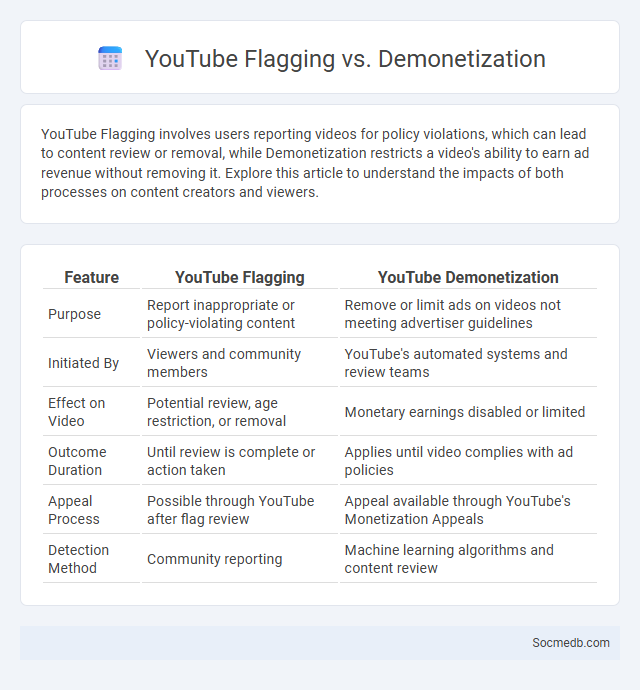
Photo illustration: YouTube Flagging vs Demonetization
YouTube Flagging involves users reporting videos for policy violations, which can lead to content review or removal, while Demonetization restricts a video's ability to earn ad revenue without removing it. Explore this article to understand the impacts of both processes on content creators and viewers.
Table of Comparison
| Feature | YouTube Flagging | YouTube Demonetization |
|---|---|---|
| Purpose | Report inappropriate or policy-violating content | Remove or limit ads on videos not meeting advertiser guidelines |
| Initiated By | Viewers and community members | YouTube's automated systems and review teams |
| Effect on Video | Potential review, age restriction, or removal | Monetary earnings disabled or limited |
| Outcome Duration | Until review is complete or action taken | Applies until video complies with ad policies |
| Appeal Process | Possible through YouTube after flag review | Appeal available through YouTube's Monetization Appeals |
| Detection Method | Community reporting | Machine learning algorithms and content review |
Understanding YouTube Flagging: Definition and Purpose
YouTube flagging is a system that allows users to report content violating community guidelines, such as hate speech, harassment, or copyright infringement. This mechanism helps YouTube maintain platform safety by enabling rapid identification and review of inappropriate videos. Understanding the flagging process is essential for creators and viewers to promote responsible content sharing and digital interaction.
What is Demonetization on YouTube?
Demonetization on YouTube refers to the process where videos no longer generate ad revenue due to violation of YouTube's monetization policies or community guidelines. Your content may be demonetized if it contains inappropriate language, controversial topics, or copyright issues, leading to reduced earning potential. Understanding YouTube's strict criteria for monetization helps creators maintain eligibility and maximize revenue from their videos.
Key Differences Between Flagging and Demonetization
Flagging on social media involves users reporting content for violating community guidelines, which triggers a review process that may lead to content removal or account warnings. Demonetization refers to the platform disabling ad revenue on certain videos or posts, often due to content that is deemed unsuitable for advertisers but not necessarily removed. These mechanisms serve different purposes: flagging enforces content policies directly, while demonetization controls monetization without restricting content visibility.
How YouTube’s Flagging System Works
YouTube's flagging system enables users to report content that violates community guidelines, such as hate speech, harassment, or copyright infringement. When flagged, videos undergo a review process by YouTube moderators or automated systems to determine if removal or restriction is necessary. The system relies on user reports, machine learning algorithms, and policy enforcement to maintain platform safety and compliance.
Common Reasons Videos Get Flagged
Videos on social media platforms often get flagged due to violations of community guidelines such as hate speech, misinformation, and explicit content. Copyright infringement and spammy behavior also trigger automatic moderation systems. Understanding these common reasons helps you create compliant content and avoid unnecessary removal or restrictions.
The Demonetization Process: Triggers and Consequences
The demonetization process on social media often begins with algorithm updates or policy changes targeting content that violates community standards or advertising guidelines. Triggers include misinformation, hate speech, or copyright infringement, leading platforms like YouTube, Facebook, and Instagram to restrict monetization as a form of content control. Consequences for creators include reduced revenue streams, diminished audience reach, and increased pressure to modify content strategies to comply with evolving platform regulations.
Community Guidelines vs. Advertiser Guidelines
Community Guidelines establish rules for user behavior, content sharing, and platform safety to foster respectful interactions and prevent harmful activities. Advertiser Guidelines concentrate on standards for ad content, targeting practices, and compliance with legal regulations to ensure ads are appropriate, non-deceptive, and align with platform policies. Both sets of guidelines work together to maintain a balanced ecosystem that protects users while supporting revenue through responsible advertising.
Impact of Flagging and Demonetization on Creators
Flagging and demonetization significantly affect creators' income and content reach on social media platforms. Your visibility and revenue streams can diminish due to algorithmic suppression or community guideline enforcement, impacting audience growth and monetization opportunities. Understanding these policies is essential to navigate risks and maintain sustainable content creation.
How to Appeal YouTube Flagging or Demonetization
To appeal YouTube flagging or demonetization, review the platform's community guidelines and monetization policies carefully to understand the specific violation. Prepare a clear, concise appeal explaining why your content complies with YouTube's rules, providing any relevant context or evidence that supports your case. Ensure Your appeal is submitted promptly through YouTube Studio's monetization tab to maximize the chances of a successful review.
Best Practices to Avoid Flagging and Demonetization
To avoid flagging and demonetization on social media, consistently follow platform community guidelines and use original, high-quality content that respects copyright laws. Optimize your posts by avoiding prohibited topics such as hate speech, misinformation, and explicit material while engaging authentically with your audience to build trust. You can enhance your channel's monetization potential by regularly reviewing policy updates and incorporating clear disclaimers or content warnings where necessary.
 socmedb.com
socmedb.com